Why you should visit the top 10 places in Samburu
Samburu is one of the major tourists attraction to the North of Kenya. It is considered a top tourist destination in Kenya with the top 10 places to visit in Samburu listed below. Due to its geographical location Samburu attracts visitors throughout the year. The social-cultural activities in Samburu such as the camel derby allow foreign and local tourists to interact with the local communities promoting trade of both skills and goods. Tourists mainly buy souvenirs made from locally available materials such as beads and hides. They also enjoy traditional delicacies from the Samburu and Maasai communities.
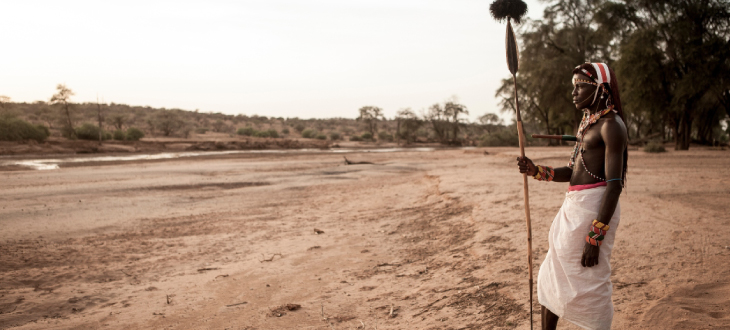
A trip to the North is mainly made possible through a travel agency that plans and executes all the trip activities for family, friends, groups, and honeymooners seeking to experience the uncommon. Transport is always available in tour vans, Landcrusers, and overland trucks.
Amongst the 10 top places to visit in Samburu are;
Samburu National Reserve
It is one of the famous Safari destinations in East Africa, Samburu National Reserve is located in Northern Kenya and is a premier game reserve situated on the banks of the Ewaso Ng’iro river. This vast savannah of remote pristine wilderness measures about 165 square kilometers in area and borders the Ewaso Ng’iro River to the south, which separates it from the Buffalo Springs National Reserve.
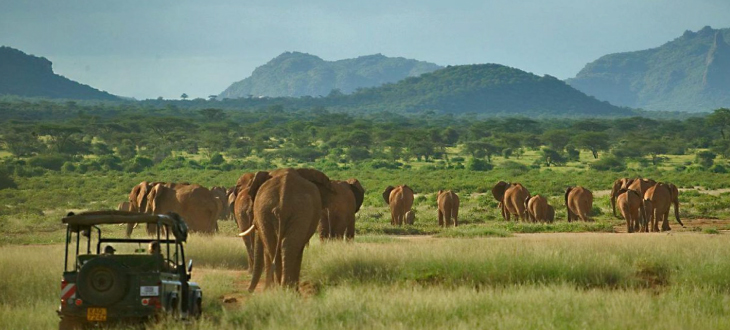
Samburu National Reserve is a unique wildlife conservation haven famous for an abundance of rare species of animals such as the Grevy Zebra, Somali Ostrich, Reticulated Giraffe, Gerenuk and the Beisa Oryx. The reserve is also home to a population of close to 900 Elephants. Large predators such as the Lion, Leopard and Cheetah are an important attraction (Kamunyak the famous Lioness that adapted a baby Oryx is a resident in the reserve). Samburu is infact one of the better locations in Kenya to spot a Leopard. Wild dog sightings are also a common attraction to this unique protected area with abundant Birdlife of over 450 recorded species.
Buffalo springs National Reserve
Buffalo Springs, Samburu, and Shaba are a trio of similar, adjoining reserves.Buffalo Springs offers good wildlife viewing of most big safari animals, and is particularly renowned for its excellent leopard sightings.
Samburu pastoralists live a semi-nomadic lifestyle on the peripheries of the reserve and a visit to a traditional homestead is highly recommended.
Buffalo Springs National Reserve, sits on the south bank of the Ewaso Nyiro, supporting a similar range of wildlife in Samburu national reserve. It is one of the most reliable places in Kenya for leopard sightings, and the springs for which it is named – a perennial marsh fed by underground water that attract plenty of wildlife in the dry season.

Situated on the south bank of the Ewaso Nyiro only 5 km east of Buffalo Springs, little-visited Shaba National Reserve. Shaba National reserve is the driest and more sparsely vegetated than its neighbours, but with a similar range of wildlife. The main game-viewing loop runs through a mosaic of lava-strewn plains, parched grassland and acacia woodland, offering glimpses to the river and passing by several hot springs. In the far east, a spring-fed waterhole once used as a campsite by Joy Adamson now attracts a steady trickle of elephant, buffalo, lion, reticulated giraffe, Grevy’s zebra and antelope.
Shaba National Game Reserve
Shaba National Reserve has a particular place in the history of Kenyan wildlife preservation, as it was home to conservationists Joy and George Adamson for many years. Joy was the renowned author of the epic”Born Free” and “Living Free” and the Sir Richard Harris filmed story of Adamsons in “To Walk with Lions”.

Between the Shaba National Reserve and Samburu National Park, wildlife is abundant. From Lions and the elusive leopard to large herds of elephants. The north is also known for special species particular in the area such as the grevy’s zebra, gerenuk (deer), beisa (oryx) and the reticulated giraffe.
Losiolo escarpment
The Losiolo Escarpment is an escarpment on the east side of the Great Rift Valley, Kenya. Rising 2,000 metres above the Suguta Valley floor on the east side near Maralal, the escarpment provides one of the most dramatic views of the Kenyan rift valley.
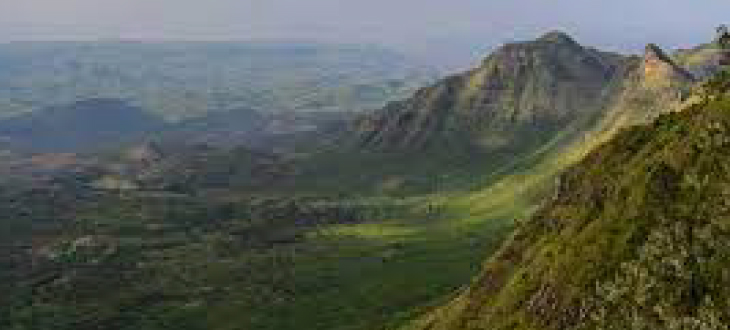
Archers Post
Archers Post is a settlement in Kenya’s Samburu County, which is home to the Samburu people. Nearby villages include Lerata. The land belongs to the Kenyan government. There is a large military training area to the north east of Archer’s Post which is used by the Kenya Defence Forces and the British Army.

While staying at Archers post, you can plan to have Expedition Happy Hour. Boat Tours, 4WD, ATV & Off-Road Tours.Visit Shaba National Reserve. Lewa Wildlife Conservancy. Nature & Wildlife Areas. And also the Meru Museum.
Reteti Elephant Santuary
Namunyak Wildlife Conservancy in northern Kenya, Samburu County is home to the first community owned elephant orphanage in Africa.
The Reteti Elephant Sanctuary was officially opened by the Samburu County Governor, H.E Moses Lenolkulal, on the 20th August 2016.
It was designed to rescue and release orphaned and abandoned elephant calves, whilst creating much needed benefits to the local people that live alongside them. The Reteti Elephant Sanctuary is the representation of the communities standing up united for wildlife, in recognition of the value that they can cultivate.
Reteti Elephant sanctuary, has created opportunities, improved community livelihoods, as well as wildlife return. Therefore proving that nature can provide a sustainable economy to the populations that occupy the magnificent ecosystem.

The Samburu community takes care of the orphaned elephants creating a community awareness about wildlife conservation, protection, and preservation. Tis illustrates a new wave of thinking about wildlife and the environment, that goes far beyond traditional conservation methods, and dives deeper into the core value of what nature represents.
On a fast developing continent where space is at a premium, the Samburu community that occupy the Namunyak Wildlife Conservancy is reversing the trends and securing their wilderness landscapes, returning to age old history of wildlife tolerance and co – existence.
The nomadic pastoralists have occupied this land for over two centuries. In an unprecedented move for wildlife conservation on community owned land, the communities have come together, and united for wildlife.
Kenyatta House
It is situated at a small distance from the centre of Maralal town, and surrounded by verdant hills. The national monument under management of the National Museums of Kenya played its fair bit during Kenya’s independence struggle. It was here that Kenya’s first president, Mzee Jomo Kenyatta, was detained as negotiations of the terms of independence were ongoing. After he had been held for 7 years at Lokitaung in northern Turkana, the pleasant setting of Maralal with a view of Mount Kenya to the south must have been meant as a first concession by the British colonial administration.

Kenyatta House displays interesting exhibits, e.g. historic photographs, the original telephone and furniture of the Kenyatta family. The visitor’s book bears an entry of the current president, the son of Mzee Jomo Kenyatta, Hon. Uhuru Kenyatta, who is said to have been conceived in Kenyatta House during the detention. Kenyatta House is surrounded by a pleasant garden. On clear days you can catch a glimpse of Mount Kenya to the South, hence the title of Jomo Kenyatta’s book ‘Facing Mount Kenya’, which he wrote during his detention in Maralal.
There is another significant historic building in town though it is not of the same importance. Mzee Jomo Kenyatta was not the only prominent freedom fighter held in custody in Maralal. A small building with two cells is still standing in which Paul Ngei was kept when he was detained in Maralal on his way to imprisonment in northern Kenya. It is said that Kenyatta was granted permission and in fact paid Paul Ngei a visit in his cell in 1960 where the two heroes strengthened their bonds.
Lobolo Camp
Lobolo camp is located midway along the western shore of Lake Turkana which in the local Turkana language means a place of abundant water. Here, natural springs support an oasis of foliage and distinct animal and birdlife.

Westgate Conservancy
Westgate Community Conservancy (WCC) is The Safari Collection’s community partnership in Samburu where Sasaab is located. Set up in 2008, Sasaab is run in partnership with the Samburu community of about 10,000 people. Sasaab protects a core area dedicated to wildlife conservation and the lodge predominantly employs its staff directly from the local community.
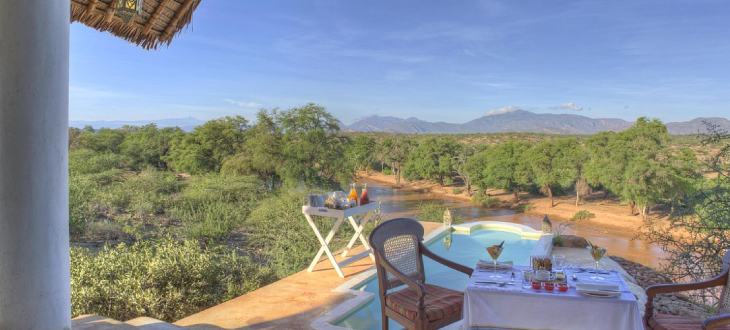
The Safari Collection runs a variety of free community medical projects each year, which has helped in building classrooms and clinics, and provides lunches to over 1,110 students in ten different schools. Since Sasaab opened it has put over one million dollars back into the Westgate Community Conservancy to help them with their own projects including security, roads, schools, clinics, and general management.
Kalama Community Conservancy
Girgir group ranch covers 32,945 hectares of land in Samburu East district, Waso division and has 700 registered member households which comprise around 5000-6000 people, all of whom are pastoralists. Kalama community wildlife conservancy is an initiative of Girgir group ranch which was established to create an alternative source of income in addition to livestock keeping.
The conservancy started in 2001 with 16,000 hectares set aside for conservation, of which 6,000 hectares was designated as a core conservation area. Grazing of livestock is permitted in the buffer zone grazing during the dry season but it is not allowed in the core conservation area. The conservancy is managed by an elected management board which draws its membership from different parts of the group ranch, and which is responsible for the day to day running of the conservancy.
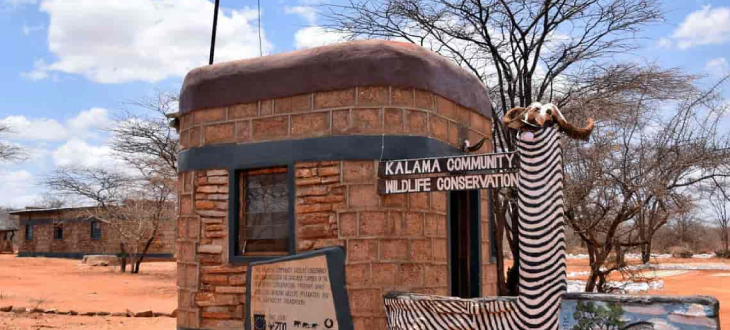
Major decisions, for example the development of eco-tourism, are made at the Annual General Meeting where all members of the group ranch are entitled to be present. The board consists of 12 elected members who serve a three year term of office, plus the area member of county assembly, the administrative chief, the community warden of the Samburu National Reserve, and one representative of the Northern Rangelands Trust. The conservancy manager is the secretary of the board.
There is also a grazing committee elected among community members which manages grazing regulations in the pasture lands. Kalama Conservancy has a fairly developed infrastructure including offices, staff quarters, roads and a water system. Initially the work was funded by Community Development Trust Fund (CDTF), which is an EU initiative under the Biodiversity Conservation Programme.
The current main donor is St Louis Zoo which has funded the operational costs of the project for the last 5 years. The Conservancy is also working with other partners and stakeholders such as the Arid Lands Resource Management Programme (ALRMP) and the African Wildlife Foundation (AWF). Kalama has recently established a small eco-lodge in collaboration with a private investor. The investor provides payments for each visitor into a community fund, and in addition there are now 18 members of community employed in the eco lodge. The conservancy employs a further 26 community members (mainly as rangers or community scouts, plus the manager, accountant, and artisans) and the conservancy also runs some camp sites for tourists.
Northern Kenya is rich in amazing traditional activities such as; Food experience, dance, culture, and social welfare. To visit the north of Kenya expecially Samburu, engage our tour consultants for an amazing tours and travel plan that is budget friendly and rich in activities. We shall book you in Amazing hotels in Samburu for a unforgettable experience.
Talk to us today. Call us on +254773578737 or email to bookings@wakenyawataliitourstravel.com



